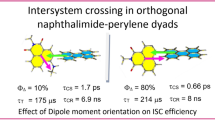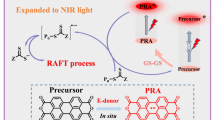Abstract
In the present study, photoinduced electron transfer (PET) dynamics between N,N-diethylaniline (DEA) and (E)-9-(4-nitrostyryl)anthracene (\(\hbox {An-NO}_{2}\)) in a non-polar solvent medium {methylcyclohexane (MCH)}, has been investigated. The rate constant of back electron transfer (\(\hbox {k}_{{\mathrm{BET}}}\)) for the \(\hbox {An-NO}_{2}\) – DEA pair was \(\sim 3.8\times 10^{5}~\hbox {s}^{-1}\) which is ca. 2 orders of magnitude less compared to the anthracene (An)-DEA (control) system. The results indicate that long-lived charge separated species can be generated using the design strategy used herein by achieving resonance stabilization of the excited state (acceptor) radical via conjugation.
Graphical Abstract
SYNOPSIS For N,N-diethylaniline/(E)-9-(4-nitrostyryl)anthracene donor-acceptor pair, the back electron transfer rate constant is \(\sim 2\) orders of magnitude slower compared to N,N-diethylaniline/anthracene system. The results indicate that organic molecules with extended \(\uppi \)-conjugation can be utilized for generating long-lived charge separated states via bimolecular PET, due to increased feasibility of charge delocalization.







Similar content being viewed by others
References
Bürckstümmer H, Tulyakova E V, Deppisch M, Lenze M R, Kronenberg N M, Gsänger M, Stolte M, Meerholz K and Würthner F 2011 Efficient solution-processed bulk heterojunction solar cells by antiparallel supramolecular arrangement of dipolar donor–acceptor dyes Angew. Chem. Int. Ed. 50 11628
Carsten B, Szarko J M, Son H J, Wang W, Lu L, He F, Rolczynski B S, Lou S J, Chen L X and Yu L 2011 Examining the effect of the dipole moment on charge separation in donor–acceptor polymers for organic photovoltaic applications J. Am. Chem. Soc. 133 20468
Sun X, Liu Y, Xu X, Yang C, Yu G, Chen S, Zhao Z, Qiu W, Li Y and Zhu D 2005 Novel electroactive and photoactive molecular materials based on conjugated donor- acceptor structures for optoelectronic device applications J. Phys. Chem. B 109 10786
Deibel C, Strobel T and Dyakonov V 2010 Role of the charge transfer state in organic donor–acceptor solar cells Adv. Mater. 22 4097
Numata T, Murakami T, Kawashima F, Morone N, Heuser J E, Takano Y, Ohkubo K, Fukuzumi S, Mori Y and Imahori H 2012 Utilization of photoinduced charge-separated state of donor–acceptor-linked molecules for regulation of cell membrane potential and ion transport J. Am. Chem. Soc. 134 6092
Higashino T, Yamada T, Yamamoto M, Furube A, Tkachenko N V, Miura T, Kobori Y, Jono R, Yamashita K and Imahori H 2016 Remarkable dependence of the final charge separation efficiency on the donor–acceptor interaction in photoinduced electron transfer Angew. Chem. Int. Ed. 55 629
Mallia A R, Salini P and Hariharan M 2015 Nonparallel stacks of donor and acceptor chromophores evade geminate charge recombination J. Am. Chem. Soc. 137 15604
Bard A J and Fox M A 1995 Artificial photosynthesis: Solar splitting of water to hydrogen and oxygen Acc. Chem. Res. 28 141
Luo C, Guldi D, Imahori H, Tamaki K and Sakata Y 2000 Sequential energy and electron transfer in an artificial reaction center: Formation of a long-lived charge-separated state J. Am. Chem. Soc. 122 6535
Ohashi M, Aoki M, Yamanaka K I, Nakajima K, Ohsuna T, Tani T and Inagaki S 2009 A periodic mesoporous organosilica-based donor–acceptor system for photocatalytic hydrogen evolution Chem. Euro. J. 15 13041
Alsam A A, Aly S M, Usman A, Parida M R, Del Gobbo S, Alarousu E and Mohammed O F 2015 Bimolecular excited-state electron transfer with surprisingly long-lived radical ions J. Phys. Chem. C 119 21896
Suneesh C V and Gopidas K R 2009 Long-lived photoinduced charge separation in flexible 9, 10-bis (phenylethynyl) anthracene- phenothiazine dyads J. Phys. Chem. C 113 1606
Rakhi A M and Gopidas K R 2015 Generation of long-lived methylviologen radical cation in the triplet-state mediated electron transfer in a \(\beta \)-cyclodextrin based supramolecular triad Chem. Phys. Lett. 618 192
de la Escosura A, Martinez Diaz M V, Guldi D M and Torres T 2006 Stabilization of charge-separated states in phthalocyanine- fullerene ensembles through supramolecular donor–acceptor interactions J. Am. Chem. Soc. 128 4112
Wolff C and Grätzel M 1977 Photoinduced electron transfer from chlorophyll-a to duroquinone in micellar solutions, charge separation through local electrostatic fields Chem. Phys. Lett. 52 542
Kim Y, Das A, Zhang H and Dutta P K 2005 Zeolite membrane-based artificial photosynthetic assembly for long-lived charge separation J. Phys. Chem. B 109 6929
Kashiwagi Y, Ohkubo K, McDonald J A, Blake I M, Crossley M J, Araki Y, Ito O, Imahori H and Fukuzumi S 2003 Long-lived charge-separated state produced by photoinduced electron transfer in a zinc imidazoporphyrin-C60 dyad Org. Lett. 5 2719
Bhattacharyya A, Malakar P and Prasad E 2017 Long lived charge separated states in vinylbenzonitrile substituted derivatives of pyrene and anthracene J. Photochem. Photobiol. A Chem. 340 88
Sun L and Goerner, H 1993 Excited-state properties of trans-1-(9-anthryl)-2-(4-R-phenyl) ethylenes with electron-donating and-accepting substituents [R= N (\(\text{ CH }_{3})\) 2, OCH3, \(\text{ CH }_{3}\), Br, CN, and \(\text{ NO }_{2}\)] J. Phys. Chem. 97 11186
Aloisi G G, Elisei F, Latterini L, Passerini M and Galiazzo G 1996 (E)-9-styrylanthracene derivatives and their interactions with electron donors and acceptors. Fluorimetric and flash photolytic studies J. Chem. Soc. Faraday Trans. 92 3315
Görner H 1999 Photoprocesses in 4-nitro-and 2, 4-dinitro-substituted trans-1-styrylnaphthalene, trans-9-styrylanthracene and related systems J. Photochem. Photobiol. A Chem. 126 15
Görner H 2002 Photoreduction of trans-4-R-4\(\prime \)-nitrostilbenes with R: OMe, H and NO 2 by di-and trialkylamines in polar media Phys. Chem. Chem. Phys. 4 482
Bortolus P, Galiazzo G, Gennari G and Monti S 2002 Photochemistry of (E)-1-(9-anthryl)-2-(4-nitrophenyl) ethene in the presence of aliphatic amines: H-bonding and charge-transfer effects Photochem. Photobiol. Sci. 1 412
Paul A and Samanta A 2007 Photoinduced electron transfer reaction in room temperature ionic liquids: A combined laser flash photolysis and fluorescence study J. Phys. Chem. B 111 1957
Okada T, Karaki I and Mataga N 1982 Picosecond laser photolysis studies of hydrogen-atom transfer reaction via heteroexcimer state in pyrene-primary and pyrene-secondary aromatic amine systems: Role of hydrogen-bonding interaction between amino group of donor and \(\uppi \) electrons of acceptor in the heteroexcimer J. Am. Chem. Soc. 104 7191
Lakowicz J R 2006 Principles of fluorescence spectroscopy \(3^{\text{ rd }}\) edn. (New York: Springer)
Nad S and Pal H 2000 Electron transfer from aromatic amines to excited coumarin dyes: Fluorescence quenching and picosecond transient absorption studies J. Phys. Chem. A 104 673
Shirota H, Pal H, Tominaga K and Yoshihara K 1998 Substituent effect and deuterium isotope effect of ultrafast intermolecular electron transfer: Coumarin in electron-donating solvent J. Phys. Chem. A 102 3089
Kavarnos G J 1993 Fundamentals of Photoinduced Electron Transfer (Berlin: VCH Publications)
D’Souza F, Chitta R, Ohkubo K, Tasior M, Subbaiyan N K, Zandler M E, Rogacki M K, Gryko D T and Fukuzumi S 2008 Corrole- fullerene dyads: Formation of long-lived charge-separated states in nonpolar solvents J. Am. Chem. Soc. 130 14263
Vauthey E and Phillips D 1990 Viscosity effect on the rate of back electron transfer within a short-lived exciplex Chem. Phys. 147 421
Bhattacharyya A, Mukherjee S, Chadha A and Prasad E 2018 Diffusion of solvent-separated ion pairs controls back electron transfer rate in graphene quantum dots J. Phys. Chem. C 122 15819
Brandes K K and Gerdes R 1967 The influence of 1, 4-dioxane and tetrahydrofuran as solvents on the stability and the solvation of negative ions of the potassium compounds of naphthalene and anthracene J. Phys. Chem. 71 508
Zahradnik R and Carsky P 1970 Conjugated radicals. II. Semiempirical calculations of electronic spectra of radical anions derived from alternant hydrocarbons J. Phys. Chem. 74 1240
Acknowledgements
A.B. and S.P. are grateful to the Ministry of Human Resource and Development (MHRD) and IIT Madras for fellowships. E.P. acknowledges the Solar Energy Research Initiative (SERI) of the Department of Science and Technology (DST/TM/SERI/ 2K11/115), India for financial support. The authors thank Prof. Ashok K Mishra and SAIF, IIT Madras for TCSPC facilities. All the authors also thank Department of Chemistry, IIT Madras for other instrumental facilities.
Author information
Authors and Affiliations
Corresponding author
Additional information
$$^{\S }$$ § Dedicated to Professor M V George on the occasion of his $$90^{\mathrm{th}}$$ 90 th Birth Anniversary.
Special Issue on Photochemistry, Photophysics and Photobiology
Electronic supplementary material
Below is the link to the electronic supplementary material.
Rights and permissions
About this article
Cite this article
Bhattacharyya, A., Pratihar, S. & Prasad, E. Photoinduced electron transfer processes of (E)-9-(4-nitrostyryl)anthracene in non-polar solvent medium: generation of long-lived charge-separated states\(^{\S }\). J Chem Sci 130, 146 (2018). https://doi.org/10.1007/s12039-018-1555-8
Received:
Revised:
Accepted:
Published:
DOI: https://doi.org/10.1007/s12039-018-1555-8




